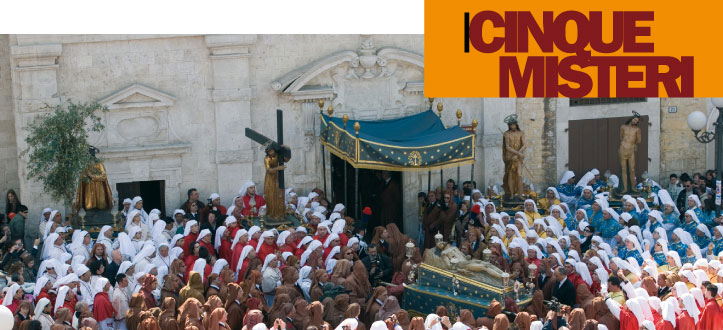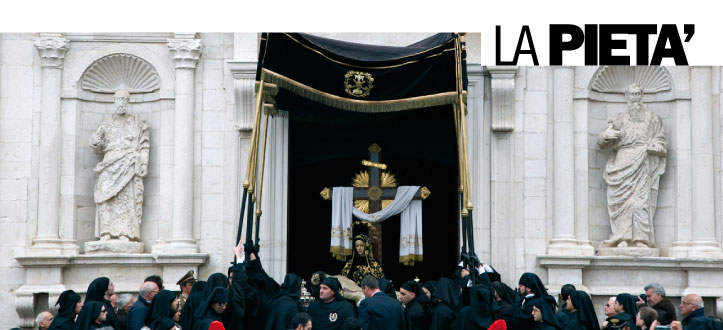





It all begins at exactly midnight, between the day of Carnival (Tuesday) and the first day of Lent, Ash Wednesday, when the procession of the Cross leaves the church del Purgatorio, to the sound of the cathedral bell as it intones thirty-three slow chimes, accompanied by the ringing of the bells of the town's other churches. The large Cross, the one that will subsequently open the holy processions of Our Lady of Sorrows, and Our Lady of Pity, is carried by a hooded brother of the Confraternity della Morte, with another two brothers on either side carrying lanterns, and follows the same route as the later processions, ending at the Calvary. From here, after a brief sermon followed by the blessings given by the Spiritual Father, the procession returns to the church del Purgatorio.
The procession, similarly to the Easter ones, is opened and led by a quartet of musicians who play an ancient oriental sounding melody for the duration of the procession. The roll of the drum, measured out by the rhythmic beating of the bass drum, accompany a flute; at the end of this motif the trumpet sounds what are known as the “ti – tè”.
On Friday before Palm Sunday, knows as Passion Friday, the procession of the Most Blessed Virgin of Sorrows statue takes place. The rite starts ad 5 in the afternoon: on the churchyard of Purgatorio’s a black baldachin is set just over the Church threshold and the statue of the Most Blessed Virgin of Our Sorrows appears; in the meanwhile the musical band of the City of Molfetta plays “La Sventurata”. The statue of the Virgin is dressed in black with a dagger stabbed in her chest representing the motherly pain. The statue in borne on the shoulders of the brothers belonging to the Arciconfraternita della Morte. The procession ends at midnight.

The Five Mysteries procession, led by the brothers belonging to the Arciconfraternita di Santo Stefano is the oldest ome; the solemn rite starts at 3.30 a.m. from the churchyard of Santo Stefano’s. the five Mysteries statues, made in the second half of the 16th century by an unknown author, represent Christ praying in the Olive Grove, Christ bound to the column, Ecce Homo, Christ at Calvary, and lasty Dead Christ. The statues are carried in slow procession across the town streets to the sounds of the funeral marches.

Twenty old wooden crosses (the oldest dates back to 1850), carried by the so-called ‘crociferi’, open the procession of the statues that crosses the streets of town centre and seems to cut the people in two wings. The statues evoke Jesus Christ’s Passion and Death. Then there is the wooden group of the Pious Women and finally the statue of our Lady of Sorrows wearing a black satin dress and a mantle embroidered with golden yarns and decorated with stars